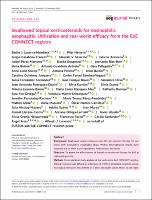| dc.contributor | Hospital General de Granollers |
| dc.contributor.author | Laserna-Mendieta, Emilio Jose |
| dc.contributor.author | Navarro Sánchez, Pilar |
| dc.contributor.author | Casabona Francés, Sergio |
| dc.contributor.author | Savarino, Edoardo |
| dc.contributor.author | AMORENA, EDURNE |
| dc.contributor.author | Pérez-Martínez, Isabel |
| dc.contributor.author | Masiques-Mas, Maria Lluïsa |
| dc.date.accessioned | 2024-04-03T08:38:35Z |
| dc.date.available | 2024-04-03T08:38:35Z |
| dc.date.issued | 2024-01-29 |
| dc.identifier.citation | Laserna-Mendieta EJ, Navarro P, Casabona-Francés S, Savarino EV, Amorena E, Pérez-Martínez I, et al. Swallowed topical corticosteroids for eosinophilic esophagitis: Utilization and real-world efficacy from the EoE CONNECT registry. United European Gastroenterol J. 2024 Jan 29. |
| dc.identifier.uri | https://hdl.handle.net/11351/11276 |
| dc.description | Eosinophilic esophagitis; Swallowed topical corticosteroids; Cross-sectional study |
| dc.description.abstract | Background: Swallowed topical corticosteroids (tC) are common therapy for patients with eosinophilic esophagitis (EoE). Widely heterogeneous results have occurred due to their active ingredients, formulations and doses.
Objective: To assess the effectiveness of topical corticosteroid therapy for EoE in real-world practice.
Methods: Cross-sectional study analysis of the multicentre EoE CONNECT registry. Clinical remission was defined as a decrease of ≥50% in dysphagia symptom scores; histological remission was defined as a peak eosinophil count below 15 per high-power field. The effectiveness in achieving clinico-histological remission (CHR) was compared for the main tC formulations.
Results: Overall, data on 1456 prescriptions of tC in monotherapy used in 866 individual patients were assessed. Of those, 904 prescriptions with data on formulation were employed for the induction of remission; 234 reduced a previously effective dose for maintenance. Fluticasone propionate formulations dominated the first-line treatment, while budesonide was more common in later therapies. A swallowed nasal drop suspension was the most common formulation of fluticasone propionate. Doses ≥0.8 mg/day provided a 65% CHR rate and were superior to lower doses. Oral viscous solution prepared by a pharmacist was the most common prescription of budesonide; 4 mg/day provided no benefit over 2 mg/day (CHR rated being 72% and 80%, respectively). A multivariate analysis revealed budesonide orodispersible tablets as the most effective therapy (OR 18.9, p < 0.001); use of higher doses (OR 4.3, p = 0.03) and lower symptom scores (OR 0.9, p = 0.01) were also determinants of effectiveness.
Conclusion: Reduced symptom severity, use of high doses, and use of budesonide orodispersible tablets particularly were all independent predictors of tC effectiveness. |
| dc.language.iso | eng |
| dc.publisher | Wiley |
| dc.relation.ispartofseries | United European Gastroenterology Journal; |
| dc.rights | Attribution-NonCommercial-NoDerivatives 4.0 International |
| dc.rights.uri | http://creativecommons.org/licenses/by-nc-nd/4.0/ |
| dc.source | Scientia |
| dc.subject | Esòfag - Malalties |
| dc.subject | Corticosteroides |
| dc.subject | Trastorns de la deglució |
| dc.subject.mesh | Eosinophilic Esophagitis |
| dc.subject.mesh | Adrenal Cortex Hormones |
| dc.subject.mesh | Deglutition Disorders |
| dc.title | Swallowed topical corticosteroids for eosinophilic esophagitis: Utilization and real-world efficacy from the EoE CONNECT registry |
| dc.type | info:eu-repo/semantics/article |
| dc.identifier.doi | 10.1002/ueg2.12533 |
| dc.subject.decs | esofagitis eosinofílica |
| dc.subject.decs | hormonas de la corteza suprarrenal |
| dc.subject.decs | trastornos de la deglución |
| dc.relation.publishversion | https://doi.org/10.1002/ueg2.12533 |
| dc.type.version | info:eu-repo/semantics/acceptedVersion |
| dc.audience | Professionals |
| dc.contributor.authoraffiliation | [Laserna-Mendieta EJ] Department of Gastroenterology, Hospital General de Tomelloso, Tomelloso, Spain. Instituto de Investigación Sanitaria La Princesa, Madrid, Spain. Instituto de Investigación Sanitaria de Castilla‐La Mancha (IDISCAM), Madrid, Spain. Laboratory Medicine Department, Hospital Universitario de La Princesa, Madrid, Spain. Centro de Investigación Biomédica en Red de Enfermedades Hepáticas y Digestivas, Instituto de Salud Carlos III, Madrid, Spain. [Navarro P] Department of Gastroenterology, Hospital General de Tomelloso, Tomelloso, Spain. Instituto de Investigación Sanitaria La Princesa, Madrid, Spain. Instituto de Investigación Sanitaria de Castilla‐La Mancha (IDISCAM), Madrid, Spain. Centro de Investigación Biomédica en Red de Enfermedades Hepáticas y Digestivas, Instituto de Salud Carlos III, Madrid, Spain. [Casabona-Francés S] Instituto de Investigación Sanitaria La Princesa, Madrid, Spain. Department of Gastroenterology, Hospital Universitario de La Princesa, Madrid, Spain. [Savarino EV] Department of Surgery, Oncology and Gastroenterology, University of Padua, Padua, Italy. Gastroenterology Unit, Azienza Ospedaliera di Padova, Padova, Italy. [Amorena E] Department of Gastroenterology, Hospital Universitario de Navarra, Pamplona, Spain. [Pérez-Martínez I] Department of Gastroenterology, Hospital Universitario Central de Asturias, Oviedo, Spain. Diet, Microbiota and Health Group, Instituto de Investigación Sanitaria del Principado de Asturias (ISPA), Oviedo, Spain. [Masiques-Mas ML] Department of Pediatric Gastroenterology, Hospital General de Granollers, Granollers, Spain |
| dc.identifier.pmid | 38284792 |
| dc.rights.accessrights | info:eu-repo/semantics/openAccess |

